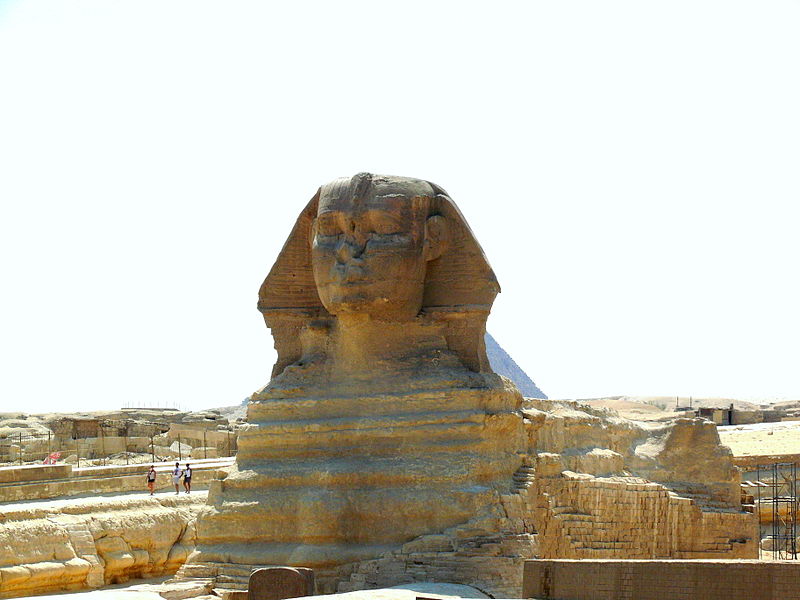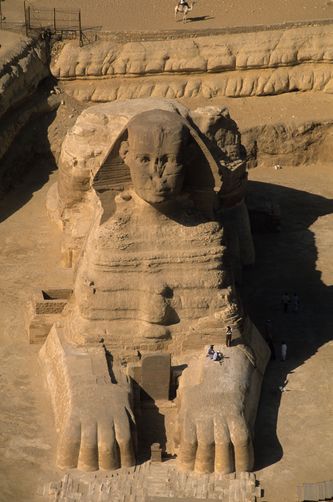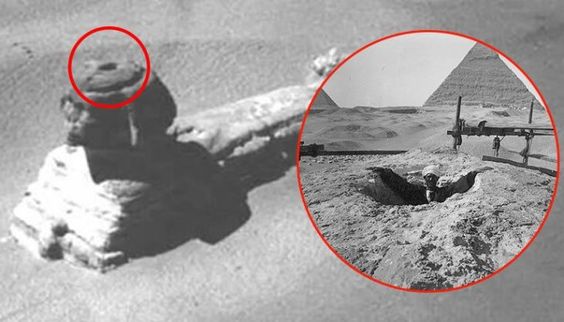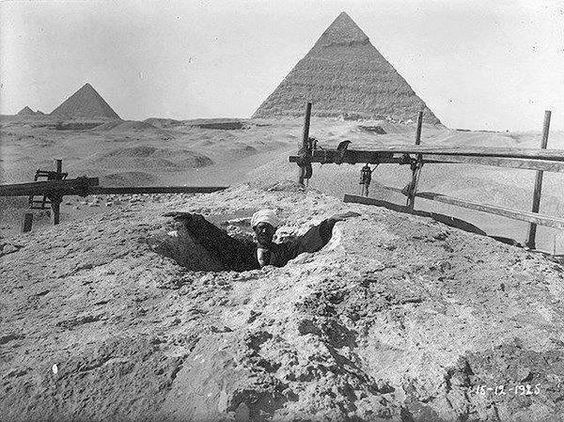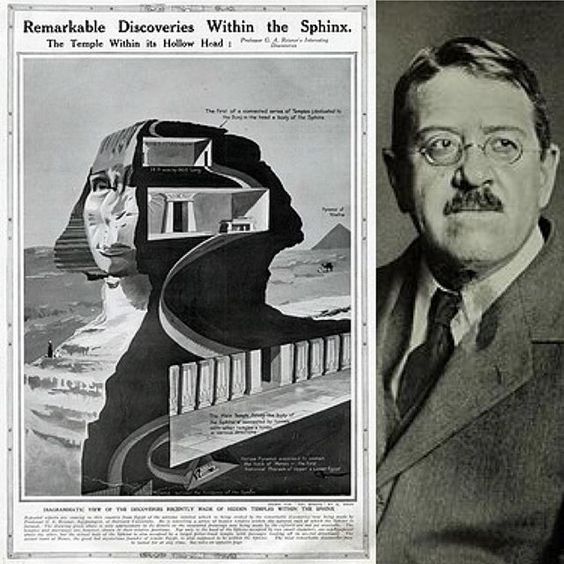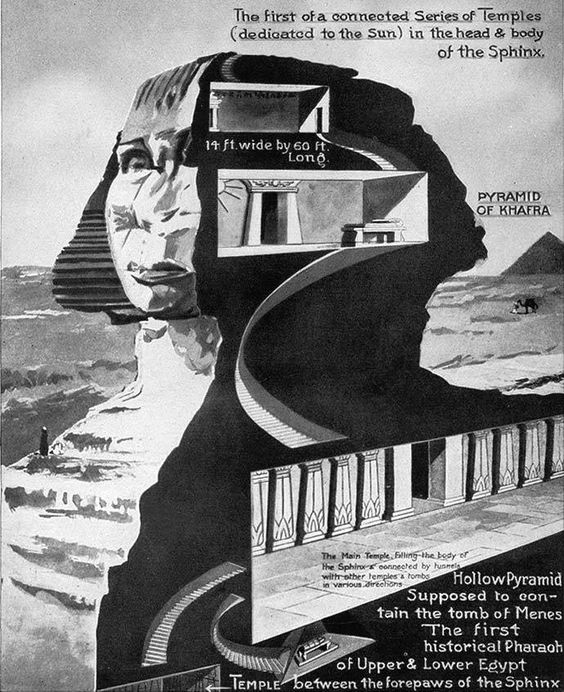It looks like you're using an Ad Blocker.
Please white-list or disable AboveTopSecret.com in your ad-blocking tool.
Thank you.
Some features of ATS will be disabled while you continue to use an ad-blocker.
share:
originally posted by: Harte
I do.
And Schoch even admitted that how weathering looks on stone has much more to do with the stone than with the weathering method.
Salt exfoliation, along with the varying resistance to weathering across the several beds that make up the sphinx, is more than enough to explain the weathering found on the sphinx and enclosure.
Harte
Well if we're going to blame the weathering on dry wind & sand (which is what I think you're saying?) then:
1. What is the salt exfoliation, if you're referring to desert wind causing the weathering?
2. If it's all desert weathering, then it just leads to more questions, like why the Sphinx body and head are weathered differently... And why it's the only structure that shows that type of weathering AFAIK...
originally posted by: Harte
originally posted by: peacefulpete
originally posted by: purplemer
a reply to: Harte
The sphinx was never under water. People believe a lot of stupid things. Harte
People beleive a lot of stupid things because they dont cross reference there opinion against fact and by not using their noggins and seeing what is in front of their eyes.
The Sphinx is carved out of solid bedrock. As you know yourself. What is the best faculty for dating stone erosion. Geology.
What do the geologists have to say about this . he 1992 in a paper by geologist Dr. Robert M. Schoch, Redating the Great Sphinx of Giza, which deals with scientific investigations of the weathering and erosion.
I discovered that the geological evidence was not compatible with what the Egyptologists were saying. On the body of the Sphinx, and on the walls of the Sphinx Enclosure (the pit or hollow remaining after the Sphinx’s body was carved from the bedrock), I found heavy erosional features that I concluded could only have been caused by rainfall and water runoff. The thing is, the Sphinx sits on the edge of the Sahara Desert and the region has been quite arid for the last 5000 years
robertschoch.com...
The best thing to do as I said is to use your noggin. Here have a look at this image below and see if you can see erosion marks both on the body of the Sphinx and on the wall enclosure. The front of the body implicitly shows water erosion as does the enclosure behind.
And whilst we are on the Sphinx have you noticed how the head is not erorded as much as the body is. Strange that since the body has been under sand for a god while.
Certainly looks like the head has been re-carved or maybe even a geopolymer added at a later date. It does appear a different colour.
Nice post, people call people stupid, for talking about water erosion, and all they have to do is look at a photo, and see it.
Can you be specific regarding the qualifications you hold for making such a determination?
Are you aware that hardly a single Geologist agrees with Schoch?
If so, do you wonder why, or is there a Geologist's conspiracy to "conceal our past from us" to go along with the one in Egyptology?
Harte
You're kinda putting words in my mouth.
I don't have any special qualifications about erosion or Egyptology etc. But life would be pretty damn limited if people could ONLY pay attention to topics that they went to school for, lol.
Re: Water erosion:
1. There are many people and sources online that believe that, and I wouldn't expect them all to trace back to one specific person?
2. The structure itself simply LOOKS LIKE water erosion. This aspect doesn't require anything more than looking at it, and comparing it to the obvious examples of water erosion that we can see... on any beach. The rocks on a beach are rounded by water erosion, just like the Sphinx body seems to be also rounded and smoothed by water erosion.
The Sphinx body also seems to have vertical channels that were cut out by water running vertically down over it...
3. I don't have a complicated conspiracy theory about Egypt's past being concealed... Except it's very obvious that the past is either lost, and / or concealed.
For example, the pyramids being built as tombs, doesn't even hold up in standard archeology, as per the lack of a tomb ever being found in a pyramid. The famous Egyptian tombs, mummies, sarcophagi, etc. have all been found buried in tombs & caves etc. built around the pyramids, but not INSIDE the pyramids.
That alone is enough to show that Egypt's true history is lost, whether on purpose or not...
Then there are crazy tunnels carved into the landscape, some of them shooting down vertically, which we can barely imagine how they were built, let alone understand WHY they were built. And such tunnels are covered with metal grates to prevent exploration.
So it doesn't need a conspiracy theory to SEE that Egypt's history has been lost, and apparently concealed, whether out of pure ignorance or whether out of intentional conspiracy, lol.
a reply to: Harte
Heck! Why you coming in here and making stuff up again!
There are plenty of geogists that think the Sphinx is far older than is accepted convectionally .
www.ancient-code.com...
www.ancient-code.com...
and btw what gives you a valid opinion. Can you be specific regarding the qualifications you hold for making such a determination. Whats your qualification in earth sciences does it mute your opinion if my qualification is larger than yours!
Can you be specific regarding the qualifications you hold for making such a determination? Are you aware that hardly a single Geologist agrees with Schoch? If so, do you wonder why, or is there a Geologist's conspiracy to "conceal our past from us" to go along with the one in Egyptology? Harte
Heck! Why you coming in here and making stuff up again!
There are plenty of geogists that think the Sphinx is far older than is accepted convectionally .
Ukrainian scientists in regards of the Sphinx, arguments based upon geological studies which support Schoch’s view regarding the Sphinx and its age. Manichev and Parkhomenko focus on the deteriorated aspect of the body of the Sphinx, leaving aside the erosive features where the Sphinx is located, which had been studied previously by Schoch. Ukrainian scholars focused on the undulating terrain of the Sphinx which displays the mysterious pattern.
www.ancient-code.com...
However, as noted Manichev and Parkhomenko, this argument does not explain why the front of the head of the Sphinx lacks such features. In regards to the argument made by Schoch about the heavy rain period which occurred around 13,000 BC, the Ukrainian scientists recognized Schoch hypothesis partially suggesting that the erosive features of the Sphinx go further back than 13.000 BC.
Manichev and Parkhomenko argue is that the mountainous and coastal areas of the Caucasus and Crimea, which they know well, have a type of wind erosion that differs morphologically to the erosive features noted on the Sphinx. Essentially, they argue that such wind erosion has a very soft effect, regardless of the geological composition of the rocks.
www.ancient-code.com...
and btw what gives you a valid opinion. Can you be specific regarding the qualifications you hold for making such a determination. Whats your qualification in earth sciences does it mute your opinion if my qualification is larger than yours!
a reply to: Harte
Some valid points. Have you got any idea why the Sphinx shows so much erosions since its spent much of its life understand. I think i would trust the hard science much more than the interpretation historians.
www.encyclopedia.com... problem this kind science/science-magazines/great-sphinx-twice-old-egyptologists-and-archaeologists-think-based-recent-geological-evidence
Some valid points. Have you got any idea why the Sphinx shows so much erosions since its spent much of its life understand. I think i would trust the hard science much more than the interpretation historians.
It is generally accepted that the Sphinx was buried in sand from approximately 2150 to 1400 b.c. It was then uncovered and repaired. From the various repairs done at different periods of history, it appears that weathering caused little erosion between 1400 b.c. and the present, but the restoration work dating from 1400 b.c. is quite substantial. If the Sphinx was built in 2500 b.c., and spent most of the following millennium under sand, how did it erode so much?
Furthermore, if the Sphinx and the tombs around it in the valley are made of the same rock (this was verified by an independent expert), and all date to the same period, shouldn't the erosion on the tombs be similar to the erosion on the Sphinx? Yet the tombs around the Sphinx show only the mild wind-blown sand weathering one would expect in Old Kingdom monuments.
www.encyclopedia.com... problem this kind science/science-magazines/great-sphinx-twice-old-egyptologists-and-archaeologists-think-based-recent-geological-evidence
a reply to: Harte
Now you said the head has been patched up. So I got an old 18th century picture of the Sphinx. Funny I can still see the erosion marks on the body and they are missing on the head. Now can you explain how this is the case.
I can answer for you if you like. Its because the body is far older and the head has been recarved it has nothing to do with Khafre. That is complety made up and based on scant to no evidence.
www.ancientpages.com...
Happy day!
Now you said the head has been patched up. So I got an old 18th century picture of the Sphinx. Funny I can still see the erosion marks on the body and they are missing on the head. Now can you explain how this is the case.
I can answer for you if you like. Its because the body is far older and the head has been recarved it has nothing to do with Khafre. That is complety made up and based on scant to no evidence.
A controversial artifact known as the Inventory Stela says that the Valley Temple and the Sphinx, already existed during the reign of Khufu, who ruled more than 30 years before Khafre.
www.ancientpages.com...
Happy day!
a reply to: peacefulpete
You dont need a qualification to have an opinion. Harta has an opinion is he an earth scientist.? I am but that means nothing. What counts is the power of the words we have.
There is other evidence to suggest the age of the Sphinx is out. But they like to disappear that kind of thing.
www.ancientpages.com...
This is all about Osiris and Isis. Make no mistake about it. The truth is being hidden. Thank you for your posts in the thread and keep being peaceful. Peaceful pete.
You dont need a qualification to have an opinion. Harta has an opinion is he an earth scientist.? I am but that means nothing. What counts is the power of the words we have.
There is other evidence to suggest the age of the Sphinx is out. But they like to disappear that kind of thing.
A controversial artifact known as the Inventory Stela says that the Valley Temple and the Sphinx, already existed during the reign of Khufu, who ruled more than 30 years before Khafre.
In other words, the stela provides evidence of a far greater antiquity for these and other Giza structures. Its text clearly overthrows the accepted theories regarding timeline of Ancient Egypt.
www.ancientpages.com...
This is all about Osiris and Isis. Make no mistake about it. The truth is being hidden. Thank you for your posts in the thread and keep being peaceful. Peaceful pete.
a reply to: Harte
You may well have written about it a decade ago. That does not give you any more credence here. You have failed to convince me that you know anymore about this than me. Infact it looks to me like you are misinterpreting information.
Why for example is the head in the 18th century image not eroded like the body is. This is what I mean about using your noggin.
I wrote the article about this that used to be in ATS' wiki (Tinwiki.) That was a decade ago.
You may well have written about it a decade ago. That does not give you any more credence here. You have failed to convince me that you know anymore about this than me. Infact it looks to me like you are misinterpreting information.
Why for example is the head in the 18th century image not eroded like the body is. This is what I mean about using your noggin.
originally posted by: purplemer
a reply to: Harte
I wrote the article about this that used to be in ATS' wiki (Tinwiki.) That was a decade ago.
You may well have written about it a decade ago. That does not give you any more credence here. You have failed to convince me that you know anymore about this than me. Infact it looks to me like you are misinterpreting information.
Then I am utterly confident that you have chosen not to check what I've posted.
originally posted by: purplemerWhy for example is the head in the 18th century image not eroded like the body is. This is what I mean about using your noggin.
Asked and answered already.
Does your noggin include an occipital lobe?
Harte
A controversial artifact known as the Inventory Stela says that the Valley Temple and the Sphinx, already existed during the reign of Khufu, who ruled more than 30 years before Khafre.
In other words, the stela provides evidence of a far greater antiquity for these and other Giza structures. Its text clearly overthrows the accepted theories regarding timeline of Ancient Egypt.
originally posted by: purplemer
a reply to: peacefulpeteThis is all about Osiris and Isis. Make no mistake about it. The truth is being hidden. Thank you for your posts in the thread and keep being peaceful. Peaceful pete.
A common fringe claim, but baseless.
The inventory stela dates to over a thousand years after Khufu was dead. But even if it was much much older, if you read it, as opposed to just reading fringe claims about it on woo sites, it doesn't even say what is claimed.
Harte
edit on 1/17/2019 by Harte because: of the wonderful things he does!
I didn't link to anything about the properties of the limestone.
This is what I would think you yourself would check before accusing me of misinterpretation.
Harte
This is what I would think you yourself would check before accusing me of misinterpretation.
Harte
Whatever was down there is long gone and we will never know our (humans) true history and place I’m the universe
originally posted by: Matt11
Whatever was down there is long gone and we will never know our (humans) true history and place I’m the universe
I highly doubt that is gone, but i do know that the real human history is being hidden. Its a lie that slaves built it.
originally posted by: AtlasHawk
originally posted by: Matt11
Whatever was down there is long gone and we will never know our (humans) true history and place I’m the universe
I highly doubt that is gone, but i do know that the real human history is being hidden. Its a lie that slaves built it.
That's correct. It's a lie.
But that's not the position of Egyptology, so your point is moot.
Regarding the hiding of history, if it's being hidden, it's being hidden from you too.
Are you trying to say you are somehow more informed than other people (such as myself) that don't believe history is being hidden?
Harte
edit on 1/26/2019 by Harte because: of the wonderful things he does!
originally posted by: purplemer
Here below is an aerial photograph of the great Sphinx. It is worth noting that aerial photography in the area is restricted. If you look at the top of the head you will note a round lighter coloured patch. It looks like it has been altered
The image below show it a little more clearer.
and the close up.
Now if you go back in time and look at older ariel images you can clearly see that the top is open.
Photo taken 15 Dec 1925
In 1914, Professor George A. Reisner of Harvard University excavated the hole on the head of The Sphinx. He came back with a story that has almost been erased from history.
In 1914, newspapers around the world reported his findings, including a temple of the Sun and also the sarcophagus of the first Pharaoh #Menes. These findings have now been erased from history books and Egyptian authorities deny the Sphinx chambers' existence.
www.pinterest.co.uk...
Its an interesting story and worthy of attention.
I wonder why they they pump out so much water from under the Shpinx.
A separate scientific update states that 260 cubic metres of water are being pumped out every hour through drainage tubes. That’s 6,240 cubic metres or 6,240,000 litres of water per day. An Olympic swimming pool has 2,500,000 litres. In short, water of a quantity equal to almost three Olympic swimming pools is pumped away on a daily basis from underneath the Sphinx!
www.eyeofthepsychic.com...
Lots more information contained in the link above
Very fascinating and intriguing story. If such a hall of records exists then perhaps the story of the antediluvial world can fully be told.
a reply to: purplemer
in which they have.
I take it you didn't actually read whats you are replying too
You cannot correctly surmise that from the image shown. You can simply correctly state that there is a hole there and if you look for the arial images you cans see that is has some depth.
in which they have.
George Andrew Reisner (Havard) had a long and notable archaeological carer. Have a read for yourself. Yet somehow you think your very limited knowledge on this subject is more correct than his. He is the one that went there not you.
I take it you didn't actually read whats you are replying too
If there is a Hall of Records and it was discovered in the Sphinx It would be kinda a let down , Egypt isn't anymore advanced or knowledgeable then
anyone else .
a reply to: Gargoyle91
There is evidence from all around the globe in the form of culture, myth and megalithic structures that suggest that a previous age of man existed and that this information is being covered up. What is meant to be contained within the hall of records is the history of all mans beginnings and ends.
If such a room is every found and the information released as opposed to covered up by the offical secrets act and rewritten history then the revaluations could be truly epic.
We are being lied to about our history. Our ancestors where trying to tell us something.
There is evidence from all around the globe in the form of culture, myth and megalithic structures that suggest that a previous age of man existed and that this information is being covered up. What is meant to be contained within the hall of records is the history of all mans beginnings and ends.
If such a room is every found and the information released as opposed to covered up by the offical secrets act and rewritten history then the revaluations could be truly epic.
We are being lied to about our history. Our ancestors where trying to tell us something.
a reply to: Harte
Hello my friend. Sorry late reply I have been busy. Yes it does appear to me that we are being lied to and our history covered up. Take the three pyramids for example. It can be clearly demonstrated that they are built by the same hand.
They have a mathematical alignment that is uniquw. They do not contain hieroglyphs. (very odd in itself) since they are normally adorned by them and all three in this respect are an enigma. The only language you can translate from them is the language of mathematics and archaeology Pharohs are always buried underground why would these ones not be.
There are megalithics on every continent (probably including Antarctica) They are often similar in stylisation and later period stone work shows a devolution.
Again for the sake of seeing the trees for the wood I shall ask you to use your noggin. Have a look at some of these quarry marks from around the world Can you explain them./.
Cave di Cusa (meaning “Quarry of Accusation in Italian
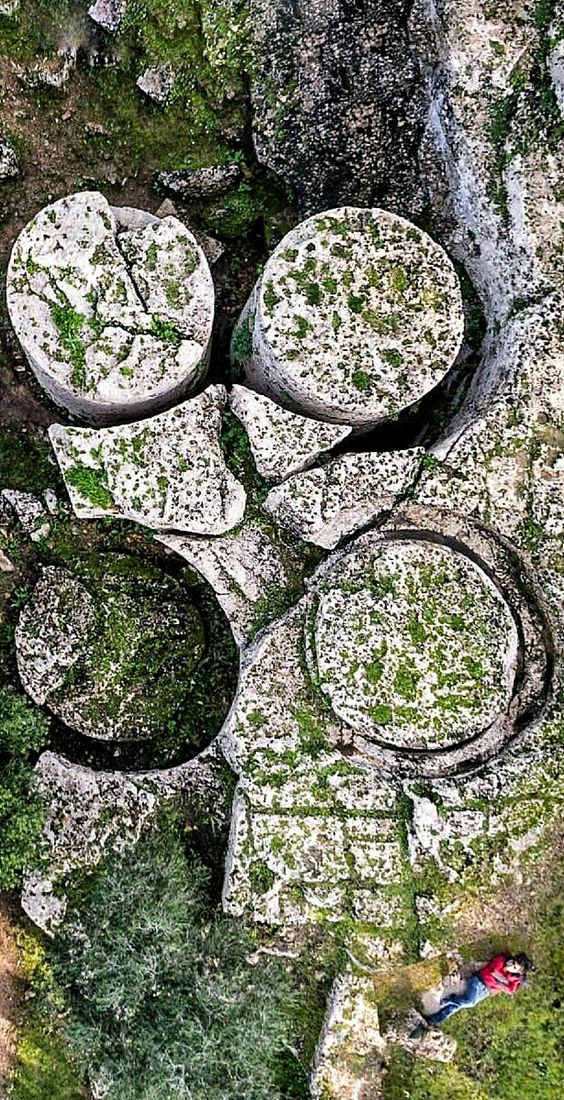
Can you not see any type of simlairty between these cultures without concluding there might be a link.
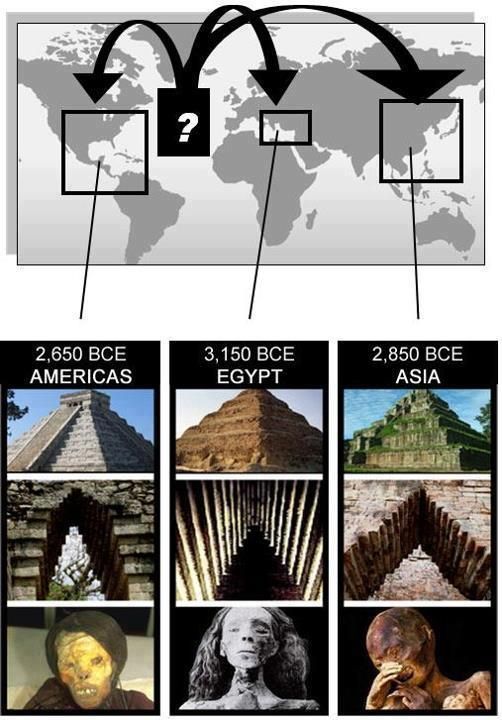
Have you seen these star holes that then turn into drill holes..
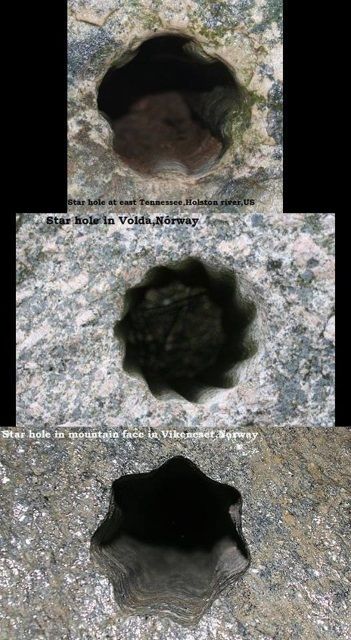
How about this 10,000 ton megalith in China.
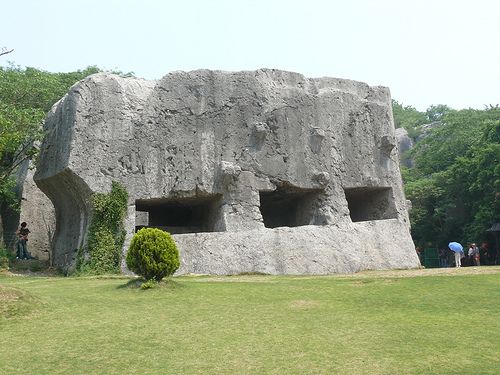
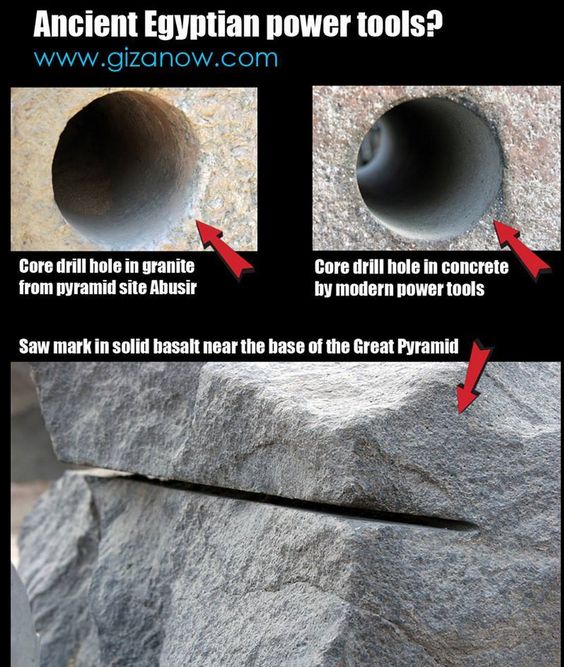

Its all very interesting stuff. Worthy of a thread of its own accord. Soz to bombard you with pictures but sometimes I think they speak a thousand words.
That's correct. It's a lie. But that's not the position of Egyptology, so your point is moot. Regarding the hiding of history, if it's being hidden, it's being hidden from you too.
Hello my friend. Sorry late reply I have been busy. Yes it does appear to me that we are being lied to and our history covered up. Take the three pyramids for example. It can be clearly demonstrated that they are built by the same hand.
They have a mathematical alignment that is uniquw. They do not contain hieroglyphs. (very odd in itself) since they are normally adorned by them and all three in this respect are an enigma. The only language you can translate from them is the language of mathematics and archaeology Pharohs are always buried underground why would these ones not be.
There are megalithics on every continent (probably including Antarctica) They are often similar in stylisation and later period stone work shows a devolution.
Again for the sake of seeing the trees for the wood I shall ask you to use your noggin. Have a look at some of these quarry marks from around the world Can you explain them./.
Cave di Cusa (meaning “Quarry of Accusation in Italian

Can you not see any type of simlairty between these cultures without concluding there might be a link.

Have you seen these star holes that then turn into drill holes..

How about this 10,000 ton megalith in China.



Its all very interesting stuff. Worthy of a thread of its own accord. Soz to bombard you with pictures but sometimes I think they speak a thousand words.
new topics
-
Ukraine halts transit of Russian gas to Europe after a prewar deal expired
Political Conspiracies: 28 minutes ago -
Welp...Happy New Year!!
General Chit Chat: 2 hours ago -
Vehicle Strikes people in New Orleans
Mainstream News: 4 hours ago -
The Hand that Rocks the Cradle - Labour Plans “diversities of our society” Curriculum Change
Regional Politics: 4 hours ago
top topics
-
Vehicle Strikes people in New Orleans
Mainstream News: 4 hours ago, 11 flags -
SCOTUS Chief Justice JOHN ROBERTS Ends 2024 Describing His Fears for Safety of U.S. Judges.
Above Politics: 12 hours ago, 4 flags -
The Hand that Rocks the Cradle - Labour Plans “diversities of our society” Curriculum Change
Regional Politics: 4 hours ago, 4 flags -
Welp...Happy New Year!!
General Chit Chat: 2 hours ago, 2 flags -
Ukraine halts transit of Russian gas to Europe after a prewar deal expired
Political Conspiracies: 28 minutes ago, 2 flags
active topics
-
Ukraine halts transit of Russian gas to Europe after a prewar deal expired
Political Conspiracies • 9 • : BedevereTheWise -
The C.D.C. Says There Was NO INFLUENZA Worth Reporting for the 2020-2021 Flu Season.
Diseases and Pandemics • 78 • : SteamyAmerican -
Vehicle Strikes people in New Orleans
Mainstream News • 24 • : SprocketUK -
‘Something horrible’: Somerset pit reveals bronze age cannibalism
Ancient & Lost Civilizations • 41 • : Xtrozero -
The Hand that Rocks the Cradle - Labour Plans “diversities of our society” Curriculum Change
Regional Politics • 11 • : angelchemuel -
How we've changed in 100 years
Ancient & Lost Civilizations • 15 • : TheMisguidedAngel -
Simulation theory and have we reset before like a game?
Conspiracies in Religions • 39 • : Xtrozero -
Welp...Happy New Year!!
General Chit Chat • 6 • : Flyingclaydisk -
SCOTUS Chief Justice JOHN ROBERTS Ends 2024 Describing His Fears for Safety of U.S. Judges.
Above Politics • 9 • : VictorVonDoom -
New UK Petition - Close the borders! Suspend ALL immigration for 5 years!
Regional Politics • 18 • : Freeborn

